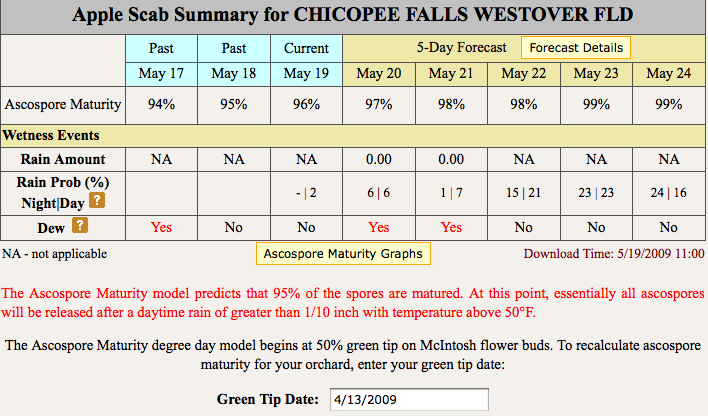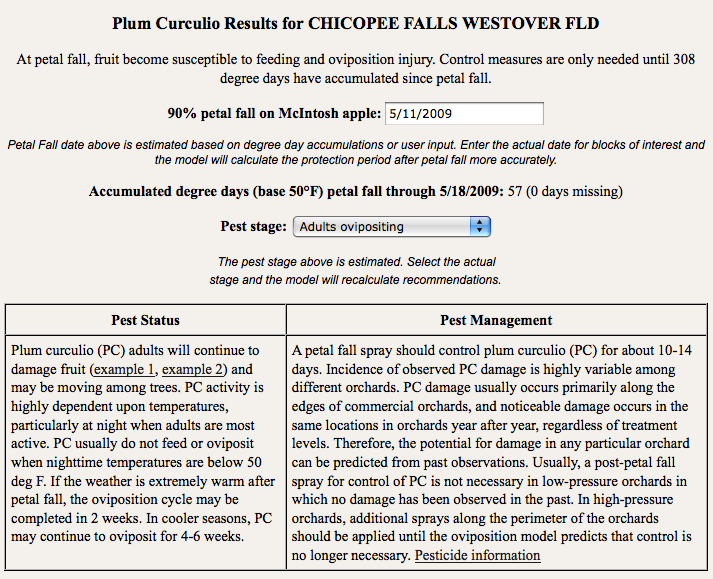Current (through May 18) degree day (DD) Accumulations
Location: UMass Cold Spring Orchard (CSO), Belchertown, MA
- Base 43: 566
- Base 50: 300
Significant upcoming orchard events based on degree days (Base 43):
- spotted tentiform leafminer sap-feeders present: 343–601
- McIntosh at fruit setl: 512–602
- lesser peachtree borer 1st catch: 486–692
- plum curculio oviposition scars present: 485–589
The way I see it
Bloom has been a bit extended and the cooler weather has slowed fruitlet development. But, looking at it right now, it's pretty obvious we do have fruit set and king fruit are definitely growing. Your results may vary, and I expect given the drawn-out bloom, set may be a little variable across locations and varieties. It might be a challenging thinning year where you will need to closely evaluate the need for fruit thinning on a block-by-block, variety-by-variety basis. (Not really the exception anyways.) I will say that reports coming out of New York suggest that the upcoming weather window through this weekend should result in a very postiive response to chemical thinning applications. This means if you are looking at fruitlets greater than 5 mm, and you feel there is a need to chemically thin, then get out there with whatever combination of chemical thinners you deem necessary -- NAA, carbaryl, BA -- and do the job. You may not have another good application window for awhile. In fact, here is the bottom-line as reported by Terence Robinson via Mike Fargione's Hudson Valley newsletter:
"The best window for thinning begins Tuesday and continues through Monday May 25. The week-long period of carbohydrate deficits which will give aggressive thinning response to thinners. For varieties that have a strong set (4-6 fruits/cluster with 80-100 of clusters set) thin with full rates from Pest Management Guidelines. For varieties with light-medium set (1-3 fruits/cluster with ≤50 of clusters set), reduce rates by 20-30%. For varieties with very light set, do not thin."
Remember, we are not the Hudson Valley, but I expect most of us in the west to south-central Massachusetts areas can heed the advice.
J. Clements
NEWA disease and insect models reality check
I mentioned the NEWA apple insect and disease models in a previous Healthy Fruit. I thought it might be useful to look at a few of those and perform a 'reality check' on them. So, below is the output of the model(s) which should be self-explanatory, along with a comment or two of mine. All model output is using Chicopee Falls (Westover Field) weather data, which is close to Belchertown (but lower in elevation). I encourage you to visit the NEWA sites and run your own models using the Weather Station closest to your orchard.
J. Clements

APPLE SCAB – Check! my own weather data in Belchertown shows for the same dates, 5/17-98%, 5/18-99% maturity, which agrees quite well with the NEWA output. I would also remind you to check out the apple scab model output -- including infection periods -- I run at Belchertown with our own weather station.

FIREBLIGHT – Check! The forecast suggests the risk of fireblight infection will be high with the upcoming hot weather predicted. Any rain or heavy dew with open apple bloom could result in high fireblight infection risk -- open bloom should be protected with a strep spray in that case. I would also remind you to check out the fireblight model output -- including Maryblyt and Cougarblight-- I run at Belchertown with our own weather station.

PLUM CURCULIO – Check! I ran degree-days from 5/11 to 5/18 and came up with 60. Pretty close. The rest is self-explanatory.

SPOTTED TENTIFORM LEAFMINER – Close? Our degree-day accumulation (base 43) through 5/18 is 566. But remember I expect Chicopee to be a little warmer. (Lower elevation and farther south.) That is the problem with extrapolating these models to other locations. But it's still pretty close, and although I have never felt I am a leafminer expert, the Pest Status and Pest Management text makes sense.

ORIENTAL FRUIT MOTH – Not sure. We are not trapping so the First Trap Catch (5/8) is estimated. Our degree-day accumulation from 5/8 to 5/18 (base 45) is 133, so that is close. The Pest Status and Pest Management statements are useful.